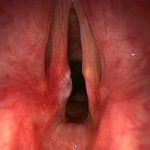 Pair of membrane covered muscles and ligaments located in the midthroat. They vibrate to produce sound.
Pair of membrane covered muscles and ligaments located in the midthroat. They vibrate to produce sound.
A fold of mucous membrane in the larynx forming the inferior boundary of the ventricle of the larynx are activated by air passing over them, and their vibrations produce sound which is the voice.
A pair of fibrous sheets of tissue which span the cavity of the voice box (larynx) and produce sounds by vibrating.
Either of two folds of tissue, each containing an elastic tissue known as the vocal ligament, that protrudes from the sides of the larynx forming a narrow slit in the larynx, called the glottis. As air is exhaled through the larynx, the vocal cords vibrate, producing sound. Movements of the tongue, lips, jaws, and accessory mouth structures mold the column of air passing through the glottis, producing sounds of different intensity and pitch.
Two folds of mucous membrane over- lying two vocal ligaments in the larynx (voice box) that vibrate to produce the sounds of speech. Most of the time the vocal cords lie apart, forming a triangle-shaped opening through which air passes for breathing. The cords also close automatically during swallowing to prevent food from going down the trachea instead of the esophagus.
The two folds of tissue that protrude from the sides of the larynx to form a narrow slit (glottis) across the air passage. Their controlled interference with the expiratory air flow produces audible vibrations that make up speech, song, and all other vocal noises. Alterations in the vocal cords themselves or in their nerve supply by disease interferes with phonation.
Either of two thin, reed-like folds of tissue within the larynx that vibrate as air passes between them, producing sounds that are the basis of speech.
One of two small bands of muscle within the larynx that vibrates to produce the voice.
Two bands of fibrous tissue located in the larynx, or voice box, that play a key role in generating voice. These vocal cords are connected at the front to the thyroid cartilage and at the back to the arytenoid cartilages.
To create sound, the vocal cords, which usually maintain a V-shaped gap, come together and oscillate when air is pushed out from the lungs through them. Changes in the tension of the cords result in varying pitches, and these sounds are further shaped by the tongue, mouth, and lips to form spoken language.
